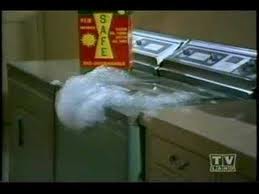Washing Machine Overflow
Greater Sacramento Area
If a washing machine over flow or malfuntion has caused flooding or water damage in your home or office.
CALL 916-985-8973 OR TOLL FREE:
1-877 784-5379
For water removal, cleanup and dryout.

Article by a 40 year appliance repair technician.
Washer Fill Problems
Overflow/flooding
Overflow is usually caused by a “stuck-open” fill valve, with the cold water half of the valve 'sticking' open from sediment buildup inside the valve.
This can also be caused by the fill system control components: pressure switch, pressure tube, or pressure tube dome/port. So let’s take a look at these.
First of all, determine whether your overflow condition is mechanical or electrical. Start the washer filling, then turn the timer off by pushing the knob in. If the fill continues, pull the washer plug. If filling continues with the washer unplugged, you have a mechanical problem - nearly always a stuck valve ass’y. Replace the fill valve.
If however, the fill stops when you unplug the machine, you are looking at an electrical fill control problem, and it gets a little more complicated.
Here a small piece of rubber or plastic tubing is handy. Unplug the washer and open the console where you’ll see the pressure switch. This is the switch with a small rubber tube, usually clear, sometimes black, attached. Pull this tube off and replace it with your short tubing. Blow a bit of pressure into the switch using your mouth, and listen for a click, then another when you release the pressure. Hear two clicks? Good! The switch is probably OK, but we’re having fun, so let’s continue!
Plug the washer back in (being aware that components in the console are now ‘hot’ - you've read my disclaimer, right?), and start the washer filling again. With it filling, again blow a bit of pressure into the switch. If the switch is good, the fill should stop and the machine should start to agitate.
This verifies that the pressure switch is working, and causes us to suspect the pressure tubing or a clogged port/dome to which it connects. Wipe off the end of the original tube you removed from the switch, and blow into it. You’re blowing air down into the tank now, and you should feel very little restriction. If it is very hard or impossible to blow through this tube, the tank dome or port is clogged.
Really old Maytags were known for this, and if you have one, spin out all water, remove the ‘Corbin’ clamp from the pressure tube outside of the tank and pull the tube off. (Pull washer front off – 2 Phillips screws at bottom, then two 3/8 in. hex screws release top, which swings upward) You will probably see ‘gunk’ clogging both the rubber tubing and the ‘spud’ that is a part of the tank. The hose ass'y can be taken to a sink and flushed clean with hot water, and an old toothbrush used to clear the tank spud, which, in the Maytags, is about 3/4 in. ID.
If your washer is a newer Whirlpool product (Whirlpool, Estate, Kenmore, Kitchenaid, Roper) with the plastic tank, these too are known for clogging, but are tougher to clear. They’re best cleaned from the inside, which means pulling the cabinet and tub. Not beyond the reach of the handyman, this job does require a special spanner wrench to remove the tub nut, as well as the removal of some other components. I’d probably recommend this one as a job for the pro. An experienced tech will have seen this before and be in and out in an hour or less.
The tank port on these washers is too small - only about 3/8 in. diameter, and hard to clean, even from the inside. Here’s yet another job for the trusty wetvac. We are hopeful that Whirlpool will soon enlarge or baffle these ports to correct this problem - one of very few ‘glitches’ these excellent machines have. Whatever your brand, if air can’t be blown down through this tube, the port or dome will need cleaning.
Note: My friend Ken told me he cleared this clog in his washer by blowing compressed air down through the pressure tube, at about 75 pounds, using his portable air tank. I'd try that first, maybe pouring a bit of hot water into the tube first, then using the air pressure to push out the 'gunk' that usually clogs the area at the pressure dome at the lower end. 'That's worth a try, as it might save the time and work of pulling the tub out. Thanks for the tip, Ken!
If you have no trouble blowing pressure through it remove the tube completely and inspect it carefully. This tube must not have the smallest hole in it, and we sometimes see them worn through or, more often, chewed through by mice. I mention this last because, while it is the least common cause of overflow I see, it does happen and is easily overlooked. We run into this a couple of times each year, usually in the Fall when the mice are looking for a warm winter home.
Also uncommon, sometimes this tube will swell and loosen a bit, leaking air where it attaches to the tank fitting. If you suspect this, or the tube fits very loosely, simply cut 3/4” or so off the end and push it back on.
One last comment on this concerns some newer Frigidaire 27” (wide) machines. These use a piece of tape (!) to secure the pressure tube to the outside of the tank. This tape has to be there (don’t ask me how I know!) or the tube will pull off while spinning, causing flooding. If it has come off, or was removed for service, be sure to replace it. Duct tape will work well; just be sure to clean the tank before attaching to be sure it stays put. Naptha (lighter fluid) will do this well.
Very important: WHENEVER THE PRESSURE TUBE IS REMOVED, BEFORE REINSTALLING IT, BE SURE ALL WATER HAS BEEN SPUN OUT OF THE WASHER! Otherwise, the water fill level will be incorrect and you’ll be back in trouble.
Copyright 2012 www.DavesRepair.com
This article may be reprinted and distributed freely
only in its entirety, including this message.
.


Water Damage or Flooding caused by a washing machine malfunction or over flow, in the Sacramento Valley CALL Toll Free:
1-877-784-5379 or
(916)-985-8973
